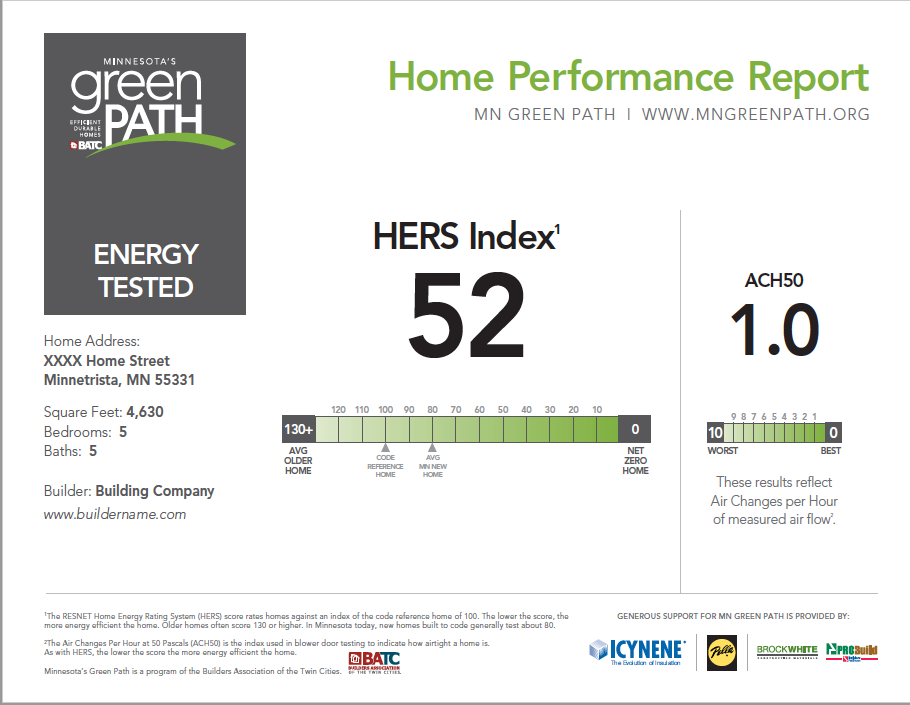The Spring 2017 Parade of Homes is again featuring a tour-within-a-tour that highlights those homes that have been independently energy tested. Sixty Four percent (306) of the Fall Parade Homes℠ are on the Green Path Energy Tour, sponsored by Xcel Energy. Each has been inspected and rated for energy efficiency by an independent Residential Energy Services Network (RESNET) rater, and can produce a Green Path Home Performance Report (HPR), which shows the home’s HERS (Home Energy Rating System) index.
Two Not-To-Miss Energy-Efficient Spring Parade Homes℠
Two of the Green Path homes on tour this spring are definitely worth touring for those interested in seeing the latest in energy-efficiency. Our Artisan Dream Home #257 by Sustainable 9 Design + Build is certified through the ENERGY STAR® program as well as being a Green Path home. The home is super insulated and solar-ready. It’s also built with state-of-the-art home automation and plenty of technology that will impress.
Another Green Path home, #350 by Christian Builders and Remodelers in Rogers features a new high-performance thermal enclosure system from Owens Corning. The extruded polystyrene insulation system is being demonstrated here even before it hits the general marketplace.
Minnesota’s Green Path
MN Green Path was created by the Builders Association of the Twin Cities (BATC) to help homebuyers better understand the expected energy use of a home, and to provide a green certification program that encourages home buyers to choose green features. At the heart of MN Green Path is the Home Performance Report (HPR), independently documenting testing results and green features for a particular home.
Previous to MN Green Path, green-build programs were only for that fraction of homebuyers who wanted and could afford a high-level of holistic green features in their home. But the reality is that most homebuyers simply won’t or can’t afford to go super green. It’s also clear that most homebuyers can’t easily assess all of the factors that contribute to a home’s energy efficiency. MN Green Path bridges these two realities.
HPR is the Key
To do that, MN Green Path’s Home Performance Report (HPR) provides current and future homeowners a concise document verifying the results of independent RESNET energy testing, graphically presenting both the home’s HERS index and ACH50 (air exchange rating) test results. For those who do want a higher level of green, Green Path Advanced and Master Certification levels are offered. These levels have strict minimum guidelines for green features, but allow the homebuyer and builder or remodeler to select from a checklist of options. The expanded Certified HPR documents all of the selected green features that are included in the home.
The ultimate goal of MN Green Path is to give homebuyers a measuring tool just like the miles-per-gallon window sticker they’ve come to rely upon when they buy a new car. Armed with easy-to understand and comparable energy and green information about a home, homebuyers are better able to assess all aspects of a home before they buy.
RESNET Testing and the HERS Index
RESNET (Residential Energy Services Network) is a California-based national association of home energy raters and energy-efficiency mortgage lenders that created the Home Energy Rating System (HERS) index to ensure a standardized, performance-based measurement for energy efficiency in homes.
RESNET certifies their independent raters, who conduct inspections in homes under construction to gather data. These raters also provide feedback and recommendations regarding energy saving choices to builders. After construction a blower door test is completed and then all the gathered data is analyzed ti establish the home’s HERS Index. The HERS is indexed against a reference home (assigned a HERS of 100), which is an imaginary home of the same size and configuration as the home being rated, and based on the International Energy Conservation Code.
Ratings below 100 indicate better energy efficiency than the reference home; over 100 means the home will use more energy. HERS ratings in older homes with little insulation, leaky windows and outdated construction techniques score well over 100. In Minnesota, a new home built just to meet energy and building codes would test at a minimum of 80. The HERS index is based on like-sized homes, so a 6,000-square-foot home with a HERS of 60 will still cost more to heat and cool than a 2,000-square-foot home with the same HERS index.
-30-
The Energy Efficient Home Tour is sponsored by Xcel Energy and the 2017 Spring Parade of Homes is sponsored by The Tile Shop.



